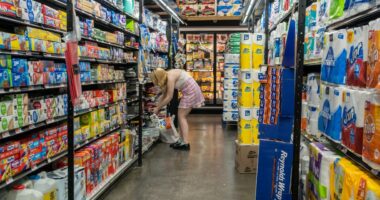
Companies face rising scrutiny of how they plan to meet their promises to decarbonize, and for most large businesses, the lion’s share of their greenhouse-gas emissions usually arise in their supply chains and consumers’ use of their products and services.
Incoming climate-disclosure rules in the U.S. and internationally mean big businesses will soon be expected to track, manage and report on those so-called Scope 3 emissions, although officials have signaled they are considering easing some of the proposed requirements.
International jurisdictions and the U.S. Securities and Exchange Commission are expected to finalize rules by this summer that will require public companies to report their greenhouse-gas emissions.
“The SEC has no role as to climate risk itself,” SEC Chair Gary Gensler said in his remarks to the U.S. House Committee on Financial Services last week. “But we do have an important role with regard to ensuring for public companies’ full, fair and truthful disclosure about material risks.”
Mr. Gensler said “hundreds of companies today are already making climate-risk disclosures” because many investors want them. The SEC’s goal is to make such information more consistent and comparable, he said.
Here is a look at what some companies are doing in preparation.
Footprint analysis to prioritize efforts: IKEA studied its footprint and found that 52% of its emissions came from the materials in its products, 14% from people using its products at home and 8% from production. Further analysis showed that fossil-based glue was responsible for about 5% of its carbon footprint, so it is switching to a biobased glue, a small step expected to deliver a large impact.
Industry collaboration to promote low-emission alternatives: The First Movers Coalition is a group of more than 60 companies committed to help low-carbon product suppliers develop their offerings and scale up by promising to buy more than $12 billion of their nascent goods and services by 2030. The group includes Google parent Alphabet Inc., BHP Group Ltd. and Ford Motor Co.
What to know about scope emissions
- Scope 1 are direct emissions generated by a company’s own operations, including those generated by the fuel to power manufacturing equipment or running its own vehicles.
- Scope 2 emissions are the indirect emissions, from energy purchases for power, steam, heating and cooling.
- Scope 3 emissions are all the rest generated in a business’s value chain, starting with the raw materials all the way through to the use and disposal of their products or services. Direct suppliers are known as tier 1 with that number increasing the deeper you go down the supply chain. Less than 5% of supply-chain leaders say they have strong visibility into their tier 2 suppliers and beyond, according to a mid-2021 survey from Gartner.
Similarly, the owners of fashion brands H&M, Zara, Gucci and Stella McCartney have vowed to collectively buy 550,000 metric tons of alternative fibers to make textiles and packaging, including those made from agricultural residues or recycled materials.
In another example of industry collaboration, companies in sectors such as electronics, packaging and clothing have banded together to pay for recycling programs known as extended producer responsibility programs, which charge producers tiny fees on individual items to fund the infrastructure development.
Partnerships with suppliers: Large companies are working with small suppliers to overcome hurdles to accessing renewable power supplies, a relatively straightforward way to cut emissions. Drugmakers, including Pfizer Inc., Biogen Inc. and Bristol-Myers Squibb Co. , have funded the Energize program that educates their suppliers and connects them with opportunities to access renewable clean-power supply agreements. Schneider Electric SE delivers the pharmaceutical group’s program and has likewise been enlisted by Walmart Inc. to connect its suppliers with renewable-power providers. There are regular workshops with Walmart’s suppliers that guide them on how to procure renewable energy as part of the retailer’s goal to avoid or reduce 1 billion metric tons of emissions from its value chain by 2030.
Walmart also is bringing its suppliers together to collectively buy long-term renewable-energy deals. In October, it said its first group was five companies, including Amy’s Kitchen Inc., Levi Strauss & Co. and J.M. Smucker Co., which agreed to a 12-year deal with Danish wind provider Ørsted AS.
Targets for lower-emission alternatives: Nestlé SA is paying a premium to farmers in its supply chain that cut emissions by following regenerative farming practices. Similarly, Apple Inc. is tracking its suppliers’ efforts to decarbonize their Apple-related manufacturing and in April said more than 250 of its global manufacturing partners are now on a path to decarbonize their Apple-related manufacturing by 2030.
Write to Dieter Holger at [email protected]
Copyright ©2022 Dow Jones & Company, Inc. All Rights Reserved. 87990cbe856818d5eddac44c7b1cdeb8









